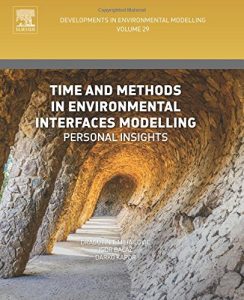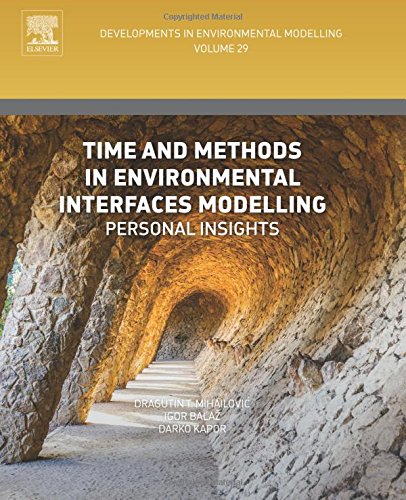Time and Methods in Environmental Interfaces Modelling Personal Insights 1st Edition Dragutin T. Mihailović – eBook PDF
$50.00 Original price was: $50.00.$35.00Current price is: $35.00.
Time and Methods in Environmental Interfaces Modelling Personal Insights – Ebook PDF
Time and Methods in Environmental Interfaces Modelling Personal Insights – Ebook PDF Instant Delivery – ISBN(s): 9780444639189,0444639187

Product details:
Time and Methods in Environmental Interfaces Modelling: Personal Insights considers the use of time in environmental interfaces modeling and introduce new methods, from the global scale (e.g. climate modeling) to the micro scale (e.g. cell and nanotubes modeling), which primarily arise from the personal research insights of the authors.
As the field of environmental science requires the application of new fundamental approaches that can lead to a better understanding of environmental phenomena, this book helps necessitate new approaches in modeling, including category theory, that follow new achievements in physics, mathematics, biology, and chemistry.
Table contents:
Part I: Introduction
Chapter 1. Environmental interface: Definition and introductory comments
Chapter 2. Advanced theoretician’s tools in the modelling of the environmental interface systems
2.1. Modelling Architecture
2.2. Basics of Category Theory
2.3. Basics of Mathematical Theory of General Systems
2.4. Formal Concept Analysis in modelling the Interaction of Living Systems and Their Environments
2.5. Basic Concepts of the Chaos Theory
Chapter 3. Approaches and meaning of time in the modelling of the environmental interface systems
3.1. Model Choice
3.2. Continuous Time Versus Discrete Time in Building the Model
3.3. Time in Model Building
Chapter 4. Examples of use of the formal complex analysis
4.1. Use of Formal Complex Analysis in the Context of Animals: An Example
4.2. Use of Formal Complex Analysis in Constructing the Subjective Interface Between Biological Systems and Their Environments
Part II: Time in Environmental Interfaces Modelling
Chapter 5. Time in philosophy and physics
5.1. Time in Philosophy
5.2. Time in Physics
Chapter 6. Time in biology
Chapter 7. Functional time: Definition and examples
7.1. Mollusk Time Reflex Formation
7.2. Prisoner Time Formation in the Cell
7.3. Functional Time Formation in Process of Biochemical Substance Exchange in Ring of Cells
Part III: Use of Different Coupled Maps in the Environmental Interfaces Modelling
Chapter 8. Coupled logistic maps in the environmental interfaces modelling
8.1. Coupling of Two Logistic Maps
8.2. An Example of Diffusive Coupling: Interaction of Two Environmental Interfaces on the Earth’s Surface
8.3. The Linear Coupling
Chapter 9. Logistic difference equation on extended domain
9.1. Logistic Equation on Extended Domain: Mathematical Background
9.2. Logistic Equation on Extended Domain in Coupled Maps Serving the Combined Coupling: A Dynamical Analysis
Chapter 10. Generalized logistic equation with affinity: Its use in modelling heterogeneous environmental interfaces
10.1. Generalized Logistic Map With Affinity: Mathematical Background
10.2. Uncertainties in Modelling the Turbulent Energy Exchange Over the Heterogeneous Environmental Interfaces — Schmidt’s Paradox
10.3. Use of the Generalized Logistic Equation With Affinity in Modelling the Turbulent Energy Exchange Over the Heterogeneous Environmental Interfaces
Chapter 11. Maps serving the different coupling in the environmental interfaces modelling in the presence of noise
11.1. Behavior of a Logistic Map Driven by Fluctuations
11.2. Behavior of the Coupled Maps Serving the Combined Coupling in the Presence of Dynamical Noise
Part IV: Heterarchy and Exchange Processes Between Environmental Interfaces
Chapter 12. Heterarchy as a concept in environmental interfaces modelling
12.1. Hierarchy and Heterarchy
12.2. Observational Heterarchy and Formalization of Heterarchical Levels
Chapter 13. Heterarchy and biochemical substance exchange in a diffusively coupled ring of cells
13.1. Observational Heterarchy and Biochemical Substance Exchange Between Two Cells
13.2. Simulations of Active Coupling in a Multicell System
Chapter 14. Heterarchy and albedo of the heterogeneous environmental interfaces in environmental modelling
14.1. Heterarchy and Aggregation of Albedo Over Heterogeneous Environmental Interfaces
14.2. Influence of the Albedo Calculation on the Effective Temperature of the Heterogeneous Grid-Box Consisting of Different Covers
Part V: Complexity Measures and Time Series Analysis of the Processes at the Environmental Interfaces
Chapter 15. Kolmogorov complexity and the measures based on this complexity
15.1. Introductory Comments About Complexity of Environmental Interface Systems
15.2. In What Extent Kolmogorov Complexity Enlightens the Physical Complexity?
15.3. Novel Measures Based on the Kolmogorov Complexity
15.4. Application to Different Dynamical Systems
Chapter 16. Complexity analysis of the ionizing and nonionizing radiation time series
16.1. A Complexity Analysis of 222Rn Concentration Variation in a Cave
16.2. Use of Complexity Analysis in Analyzing the Dependence of 222Rn Concentration Time Series on Indoor Air Temperature and Humidity
16.3. Use of the Kolmogorov Complexity and Its Spectrum in Analysis of the UV-B Radiation Time Series
Chapter 17. Complexity analysis of the environmental fluid flow time series
17.1. Complexity Analysis of the Mountain River Flow Time Series
17.2. Randomness Representation in Turbulent Flows with Bed Roughness Elements Using the Kolmogorov Complexity Spectrum
17.3. Application of the Complexity Measures Based on the Kolmogorov Complexity on the Analysis of Different River Flow Regimes
Chapter 18. How to face the complexity of climate models?
18.1. Complexity of the Observed Climate Time Series
18.2. Complexity of the Modeled Climate Time Series
Part VI: Phenomenon of Chaos in Computing the Environmental Interface Variables
Chapter 19. Interrelations between mathematics and environmental sciences
19.1. The Role of Mathematics in Environmental Sciences
19.2. Difference Equations and Occurrence of Chaos in Modelling of Phenomena in the Environmental World
Chapter 20. Chaos in modelling the global climate system
20.1. Climate Predictability and Climate Models
20.2. An Example of the Regional Climate Model Application
20.3. Occurrence of Chaos at Environmental Interfaces in Climate Models
Chapter 21. Chaos in exchange of vertical turbulent energy fluxes over environmental interfaces in climate models
21.1. Chaos in Computing the Environmental Interface Temperature
21.2. A Dynamic Analysis of Solutions for the Environmental Interface and Deeper Soil Layer Temperatures Represented by the Coupled Difference Equations
Chapter 22. Synchronization and stability of the horizontal energy exchange between environmental interfaces in climate models
22.1. Synchronization in Horizontal Energy Exchange Between Environmental Interfaces
22.2. Stability of Horizontal Energy Exchange Between Environmental Interfaces
People also search:
j and e model
lag time environmental science
met environmental
r interrupted time series analysis
r timereg
zmet technique
zmet method


